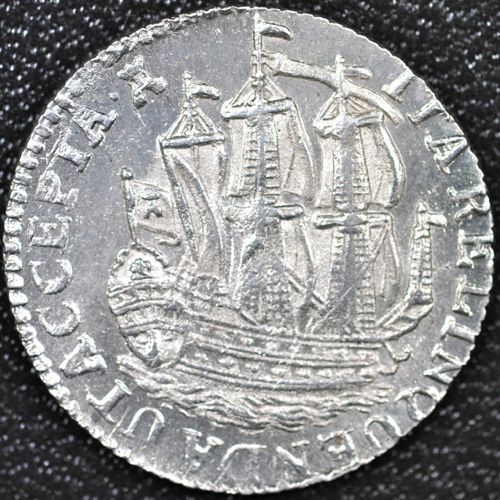Options
1780 Zeeland (Netherlands) Scheepjesschelling or Ship Shilling in UNC (Some more info added in 3rd p
To be send to our hosts soon...I wanted pictures before it gets encapsulated.
A relatively common coin, in VF or XF that is. UNC's are very scarce. This one doesn't seem to have enough luster (and a somewhat weak strike, but I've never seen a later date such as this truly fully struck) for a gem but should at least grade 63 or 64:


Most of these were meant to be sent to the colonies in the Indies (present-day Indonesia) where they circulated on a large scale. This would have gone on a VOC ship, the Dutch East India Company, which went bankrupt nineteen years later, in 1799. Still for me these signify the wealth of the 17th century Dutch Republic and the Naval power that it was at the time.

A relatively common coin, in VF or XF that is. UNC's are very scarce. This one doesn't seem to have enough luster (and a somewhat weak strike, but I've never seen a later date such as this truly fully struck) for a gem but should at least grade 63 or 64:


Most of these were meant to be sent to the colonies in the Indies (present-day Indonesia) where they circulated on a large scale. This would have gone on a VOC ship, the Dutch East India Company, which went bankrupt nineteen years later, in 1799. Still for me these signify the wealth of the 17th century Dutch Republic and the Naval power that it was at the time.
0
Comments
But mine wasn't UNC, and it had a hole in it.
PS- nice coin, BTW. Our late Newbiecollector would have approved.
Here's one from my main collecting field, the province of Gelderland. Of all 33 million of this type struck by all provinces combined only about 8% were struck by Gelderland, all on special request by the VOC and all sent to the Dutch East Indies. There are a limited number of dates (1705-1707, 1709-1712, 1715-1717 and 1734) plus two later dates known in gold (1760, 1785). Just to give you an indication of the rarity of these pieces even in silver:
-1704, 1706, 1710, 1711, 1712, 1734: Encountered very infrequently, some dates more than others. Don't expect more than one or two opportunities for each date every year, at most.
-1707 & 1709: Even scarcer, I've only seen a few of both.
-1715: Unique, only known on a square planchet. In a museum
-1716: Mentioned in old catalogs, unsure if this date even exists. It does not appear to have been auctioned in say, the last century or so.
-1717/2: Perhaps two or three known. Last sale was in 2001.
Collecting these things is fun, but you can't expect to have even anywhere near a complete collection. I have given up on quality pieces from Gelderland...any that I encounter that don't look too bad I try to get. You can't be picky when it comes to many of these coins as it might be the only one for sale in many decades.
Like VOC Numismatics on facebook
Like VOC Numismatics on facebook
Like VOC Numismatics on facebook
<< <i>The only coin that I have from there is this 1/2 suit. There is some verdigris in the surfaces which I am afraid to touch. -Dan
I've never heard of an 1/2 suit? What denomination is that?
It's a doit, Dutch spelling duit, which is 1/8th of five cents. Yours is particular interesting for the reverse legend "Luctor et Ementor" (I struggle and go under). The correct legend is "Luctor et Emergor" (I struggle and emerge). This is thought to be a joke by the die cutter, perhaps by approval of Martin Holtzhey, who became mintmaster that year.
More info on Martin Holtzhey
Like VOC Numismatics on facebook
<< <i>I corrected it twice but the auto-correct text took over!
I've had that happen a time or two
Like VOC Numismatics on facebook
this very common coin has a value of 2 Stuivers , the Ship shilling of Dennis has a value of 6 Stuivers.
another more popular translation of Luctor et Emergo : I struggle and keep afloat.
the motto on the Ship shilling is: ITA RELINQUENDA UT ACCEPTA which rougly translates in : Pass me on as you have received me,
a friendly request not to shave any silver of the rim.